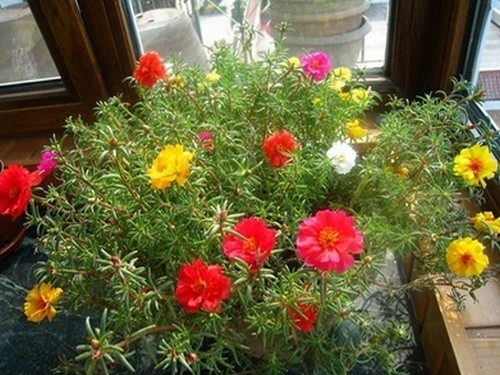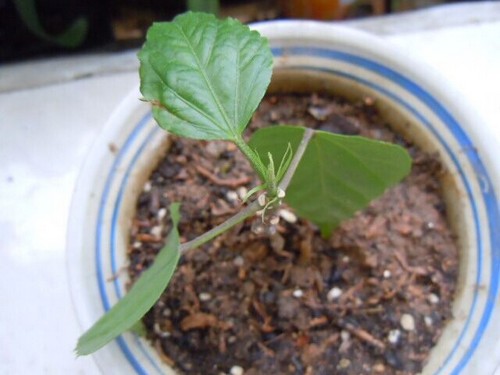Family propagation methods of Scutellaria barbata in pots
Half lotus, also known as Portulaca oleracea, sunflower, is an annual herbaceous flower of Portulaca oleraceae, semi-erect, about 20 cm high, columnar alternate, peanut branch top, numerous flowers, colorful flowers, bright red, white, yellow, light yellow, rose red, snow green, because it is easy to raise, pot planting is suitable, so it is very popular.
It is native to Brazil, like warm, not cold-resistant, like sunny high dry places, flowers open after sunrise, sunset flowers will be closed, cloudy days will open less. Lax requirements on the soil, resistance to drought and barren, avoid waterlogging, can sow and breed on their own.
The propagation of half lotus is mainly used for sowing and cutting. The seeds are usually sown in April, and the seedlings emerge in about a week. The seedlings grow slowly at the initial stage, accelerate in 6 months, and generally blossom more than two months after sowing. The cutting can be carried out in the growing season and is easy to survive. It is suitable for families to breed in small quantities.
The cultivation and management of half-branch lotus is simple, and the transplantation is easy to survive. During the whole growth period, it is required not to dry or stain, and to apply fertilizer properly, if it can ensure sufficient sunshine, it can blossom and flourish.
When the lid of the capsule of the lotus is yellowish-white or gray-white, it indicates that the seed is ripe and should be harvested in time, otherwise, the capsule will be cracked and scattered and cannot be collected.
Half lotus is called "pine needle peony" because its leaves are like pine needles and flowers are like peonies. Half a lotus sees the sun blooming and closes in the morning, evening and cloudy day, so it has the name of "sunflower" and "noon flower". The half-branch lotus is rich in color, including white, yellow, red and purple. When sowing, it should be noted that the seeds are small and should not be covered with soil, just press the flat bed directly. In addition to ensuring the necessary moisture at the seedling stage, it is not necessary to water frequently during the growing period.
Scutellaria barbata is a kind of traditional Chinese medicine, which has the functions of reducing swelling and pain, promoting blood circulation and removing blood stasis, clearing heat and detoxification, anti-cancer and so on. Deeply loved by the market, then, how to raise seedlings of Scutellaria barbata?
Scutellaria barbata soil selection:
Scutellaria barbata likes warm climate and humid, half-yin and half-yang environment, it is appropriate to choose loose, fertile, well-drained soil to plant, avoid stagnant water.
The seed propagation of Scutellaria barbata is mainly seed propagation, and it can also be propagated separately.
1. Seed propagation
The seeds were collected by ①. When the small seeds turn yellowish brown in autumn, collect the mature seeds in time, dry them, remove impurities, put them in a cloth bag and store them in a dry and ventilated place.
Seedlings were raised by ②. In spring, from March to April, and from September to November, a shallow trench (4mur6cm) was planted on a flat and raked seedbed with a row spacing of 15cm to 20cm. The sowing width was 10cm, and the bottom of the ditch was sprinkled with appropriate amount of ash, watering or thin human feces and urine, then evenly sprinkled with seeds mixed with fine soil, then sprinkled with a thin layer of fire ash or loess, and finally covered with straw and other mulch. The seedbed is often kept moist and generally germinates and emerges in about half a month. After emergence, remove the cover grass, strengthen the seedling stage management, the seedling height is about 5 cm and transplant into the field.
Live on ③. It is usually carried out in spring. On the finished border surface, the ditch is opened according to the row spacing of 30 cm, and the ditch depth is 3 cm. The seeds mixed evenly with fine fire soil ash or fine loess are scattered evenly into the ditch, covered with a thin layer of fine fertile soil, and then covered with grass to keep the soil layer moist. After about half a month, the seedlings emerged, after the seedlings were uncovered, the cover grass was removed, and the seedling stage management was done well, with a seed consumption of 1 kg per mu.
2. Ramet propagation will be dug out together with whisker root after harvest in autumn. The rootstock with strong growth and disease-free insects was selected and divided into several small ones, and then on the whole planting ground, the holes were dug according to the row spacing of 30 cm and the plant spacing of 7 mi. 10 cm, a small tree was planted in each hole, the soil was compacted after planting, and the thin human and animal dung water was applied, and the seedlings germinated the following spring.
Time: 2019-06-11 Click:
- Prev

Propagation and seedling raising method of scutellaria barbata
The propagation of half-branch lotus uses sowing and cuttage method more often. Sowing is usually carried out in April, seed germination suitable temperature is 21-22℃, about 7-10 days of emergence, seedling growth is slow in the early stage, into June after the growth accelerated, generally more than two months after sowing can bloom. Cuttings can be carried out during the growing season
- Next

The Cuttage Propagation technique of Mulberry Flower
Fusang flowers are deeply loved by everyone. If there are some walls in the house, or even a corner that is not very beautiful, you can plant a mulberry flower. He is growing so fast that he can make up the corner right away. And his roots won't hurt the wall base. But you can't plant it too close to the window, because he's growing fast.
Related
- Fuxing push coffee new agricultural production and marketing class: lack of small-scale processing plants
- Jujube rice field leisure farm deep ploughing Yilan for five years to create a space for organic food and play
- Nongyu Farm-A trial of organic papaya for brave women with advanced technology
- Four points for attention in the prevention and control of diseases and insect pests of edible fungi
- How to add nutrient solution to Edible Fungi
- Is there any good way to control edible fungus mites?
- Open Inoculation Technology of Edible Fungi
- Is there any clever way to use fertilizer for edible fungus in winter?
- What agents are used to kill the pathogens of edible fungi in the mushroom shed?
- Rapid drying of Edible Fungi

